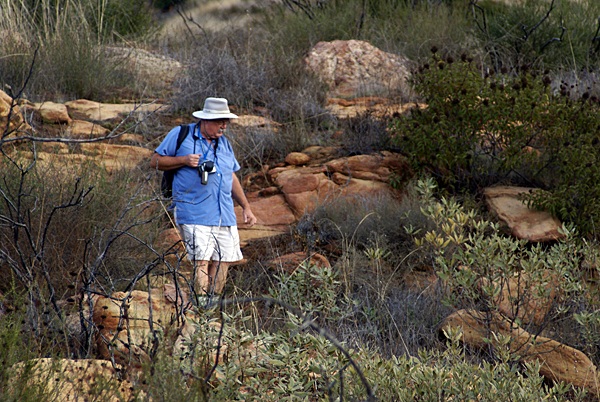Sometimes, when I hide a cache, I like to have the cache tested out by someone else. A beta tester to a geocache serves a couple of important functions for the cache hider. The primary job of the beta tester is to check the coordinates of the cacher.  Sometimes, when the coordinates have been gathered, they aren't necessarily the most accurate.
Sometimes, when the coordinates have been gathered, they aren't necessarily the most accurate.
As I posted in my last post, the accuracy of hand held GPS receivers are only good to about 30 feet. When I got to the degree confluence, my receiver said I was at the point +/- 7 feet. That was pretty good, but thirty feet could be a different story, especially if you're looking for a smaller type of container, which is where the beta tester comes into play.
I've been a beta tester on a couple of caches. I enjoy being a beta tester for a number of reasons. Sometimes, it's interesting to watch a person as they go through their hide process. Other times, it's interesting to see how close our two GPSrs are with regard to signal. Sometimes they're way off and the hider will have to do some checking to see whether it's his unit or mine that appears to be off. It can go either way.
The last time I was a beta tester, I chose to stand several hundred feet away and take pictures of the scenery. I also took a picture after my friend Chaosmanor had hidden his cache and watched as he tried to verify his coordinates. There was no way I could have seen where it was hidden and I actually had a tough time finding his cache, although I shouldn't have since it was fairly exposed from a certain angle. I didn't approach the cache from that particular angle and had a more difficult time finding it.
On another of his cache hides, he called out his coordinates to me and I inputted them into my receiver and then went on the hunt. My receiver sent me over there, which disagreed with his receiver.  But in this case, his receiver was also pointing to where mine had been pointing and so he had to take additional readings to make sure his coordinates were accurate. In this case, it helped having that second GPSr along to verify the coordinates.
But in this case, his receiver was also pointing to where mine had been pointing and so he had to take additional readings to make sure his coordinates were accurate. In this case, it helped having that second GPSr along to verify the coordinates.
The second reason I like to have another cacher beta test my hides is I get to see the reaction of someone finding the cache. On my last hide, CraigsOutside came along on the hike. I had already hidden the cache, but was having some proximity issues with another one of my own caches. This particular multi-cache had to have its second waypoint moved in order to be published. The look on CraigsOutside's face when he found both ends of the cache was priceless. As a cache owner, you only get to rely on the log write-ups of others to see how good the cache is most of the time. When you get to see others attempt your own cache, it furthers the fun.
In reality, I think that every cache hide should have a beta tester. I think many people hide caches too quickly and don't get accurate readings for their cache hides. This leads to frustrations for cache hunters when the coordinates don't end up being very accurate. Even with an accuracy rating of +/- 30 feet, there are things that a cache owner can do to make sure that accuracy is better than that.
Having patience when taking the initial coordinates is probably the first thing that a cache owner can do to insure accurate readings. Taking more than one reading, or averaging the initial reading is always helpful, especially if there is overhead site disturbances, such as trees that could block the signals from the satellites above. Having a beta tester along for the ride will also help, in my opinion.
Pictures were taken at or near the following geocaches:
Sandstone Game Paths - by Chaosmanor
Pathfinder 59s - by Chaosmanor
Friday, November 26, 2010
Beta Testing
Posted by
Paul Myers
at
12:04 PM
Labels: geocaching, Ribbit
Subscribe to:
Post Comments (Atom)

1 comment:
And, of course, beta-testers get a smiley :-)
The vast majority of our hides in the past couple of years have had a beta-tester, and I agree that having one adds immensely to the experience. Unless one has already picked out a precise spot (not very often for our hides), there is the added aspect of wanting the hide to be really good, so that the tester has to work a bit to find the cache. It takes longer, as spots are found and then rejected for one reason or another, but the final result tends to be a better hide. Just because the tester gets a "free" smiley doesn't mean that it has to be an easy one.
The Art of Hiding is in danger of being overwhelmed by the perceived need to fill up every node in the tenth-mile grid. I don't mind cachers wanting to put a cache every 530-550 feet along a trail, a road, a whatever, but there are few things that will earn derision quicker, and be long-lasting, than poor coords. Unfortunately, far too few newcomers understand this, and when they get complaints, they either lash out, or they give up. Which is a shame when a little time spent, and help requested, on numbers verification can avoid that.
Post a Comment